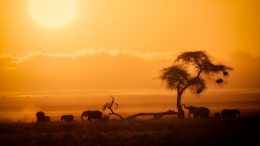In recent weeks and months, Donald Trump and other leaders and pundits around the world have taken aim at diversity and inclusion efforts in government, schools, and businesses.
As a conservation professional, I’m working to embed more diversity and inclusion in my efforts — and in the process making biodiversity protection more effective.
I’ve accomplished this through the relatively new field of conservation psychology.
Conservation psychologists study the intersection between people and biodiversity protection by examining environmental justice; human behavior, attitudes, and perceptions; environmental education; community-based conservation and capacity building; and the many ways in which we relate to our natural environments, amongst other topics
This merging of conservation with social aspects is new in the field of psychology. But transitioning from psychology as a therapeutic practice to studying the human aspects of conserving biodiversity has given me the opportunity to witness the need to shift toward an ethos of coexistence. Through my work, I’ve highlighted the many ways in which conservation needs to be more inclusive of people, as well as the ways in which people can more willingly embrace pro-environmental behaviors.
With the climate and extinction crises continuing to worsen, this is the perfect time for conservation psychology and other social sciences to play a pivotal role in transforming conservation into a space that is participatory, inclusive, and diverse — areas in which traditional western models have failed.
A Crisis of Exclusion
We face undeniable threats to biodiversity across the world, all of which endanger a multitude of ecosystem services that both humans and nonhuman species depend on. Calls to protect biodiversity started in the 1970s, yet we’re still in desperate search for solutions amidst increasingly urgent reminders that plant and animal life are rapidly disappearing.
In the face of the growing urgency from scientists and policymakers, why do we still face an imminent crisis?
This is a complex question, but a major shortfall of historical conservation efforts has been the omission of the human aspects of preserving biodiversity. Early efforts resorted to complete exclusion of people — primarily local and Indigenous communities — to create “pristine” habitats devoid of a human footprint. Such spaces later became open to travelers seeking out untouched environments — a privilege limited to those who could afford the exclusivity of access.
The legacy of this exclusion endures, compounded by issues such as poverty, food insecurity, and resource scarcity.
Outside Looking In?
The overtly exclusionary ways of conducting conservation echo deeply in our severed connections and relationships with the natural world, in which we exist outside of nature as if we, as people, need to be separated.
This happens in two ways, both perpetuating the notion of a human-nature dichotomy.
The first is the philosophy that we must separate ourselves from nature for nature’s sake. Humans, in this model, are considered a hostile presence and must remain removed from natural spaces.
The second is the belief that nature is “out there,” something messy, a little too wild and unsanitized for our increasingly urbanized existence. The continuous use of pesticides and herbicides, destruction of natural spaces, and an aversion to non-companion animals in our spaces are all indicative of a worrying rift growing between people and nature.
But nature has long been shaped, even subtly, by a human presence, as demonstrated by the richness of biodiversity that many Indigenous and First Nation lands sustain. And we can’t survive without a thriving environment: Striving for separation from nature is a dangerous pursuit.
The Extinction in Our Culture
More than 20 years ago ecologist Robert M. Pyle coined the term “extinction of experience” to describe our increasing separation from and hostility toward nature.
This separation has diminished the mental and physical wellbeing so often derived from nature and decreased our pro-environmental behavior and attitudes. With each successive generation, children grow up in a world in which nature is continuously diminished and experience less exposure to nature than their parents and grandparents.
According to Peter Kahn, a psychology professor at the University of Washington, this has caused “environmental generational amnesia” — a lack of natural spaces simply becomes the norm or standard by which each generation judges what is considered to be the natural environment, despite its degradation.
Time to Shift
The fact that we’re studying and talking about generational amnesia is a sign that we’re starting to see enormous shifts in research and the ways in which we conduct conservation to change behavior.
The growing interest in incorporating social sciences like conservation psychology into the natural sciences appears to be partially responsible for this shift. Through a recognition that people are part of the natural world, not apart from it, we can more creatively consider how that should look in ways that don’t exclude, discriminate, or cause harm.
An exciting element of the field of conservation psychology is that it’s still relatively new but rapidly gaining traction. It was founded in the early 2000s by Carol Saunders and has already become one of the official professional divisions of the American Psychological Association. This newness and recognition create enormous space for growth and creativity for researchers to explore the nexus between people, biodiversity, and protecting our natural world.
Giving People (and Species) Voice
My own research has focused primarily on capacity building, photographic storytelling in conservation, and advocating for a diverse, justice-foregrounded means of conducting biodiversity protection.
My colleagues and I used a creative methodology called photovoice to learn about the graduates of a capacity building initiative called Wild Shots Outreach. We explored their experiences living in the Greater Kruger region of South Africa, including their experiences of exclusion from protected land, the legacy of apartheid, and how they view conservation and capacity building. The findings strongly suggest that promoting justice, human wellbeing, and representation through capacity building can help conservation practitioners achieve more inclusive, positive outcomes for both people and nature.
Through this research we see that conservation psychology has much to offer the field of conservation, both in theory and practice. By incorporating a much stronger recognition of issues of justice, we can begin to recognize where redress may be needed and embrace greater diversity.
Issues of justice can include nonhuman species, too, as seen in the field of ecological justice. This remains a largely untapped area of research that holds enormous promise to transform biodiversity protection. Going forward, researchers and practitioners need to be mindful of the multitude of ways in which social, environmental, and ecological justice need to be addressed for enduring change.
Moving Forward
In 1985 biologist Michael E. Soulé positioned conservation studies as a crisis discipline — one that seeks solutions to urgent problems that affect all life forms, including our own, and recognizes the significance and gravity of conservation in which practitioners and researchers from multiple backgrounds can contribute to biodiversity protection.
Although the social sciences have been slower to take a firm hold in conservation, Soulé made an interesting point — the conservation sciences depend on the social sciences for effective implementation.
As social scientists, psychologists have much to offer the conservation sciences — from design, implementation, and evaluation — to provide new, creative perspectives and skills that more consciously include the human components of conservation work. After all, conserving biodiversity means working with people, given our significant anthropocentric footprint.
For those pursuing a career in psychology and wanting to contribute to environmental issues, your expertise can also provide valuable insights into topics of community engagement, environmental education, behavior change, communication strategies, public health, and wellbeing.
There’s no more important time than now to transform conservation and biodiversity protection in ways that appreciate all the complexities and nuances of our relationships with nature.

Previously in The Revelator:
The Challenges of Studying (and Treating) PTSD in Chimpanzees


